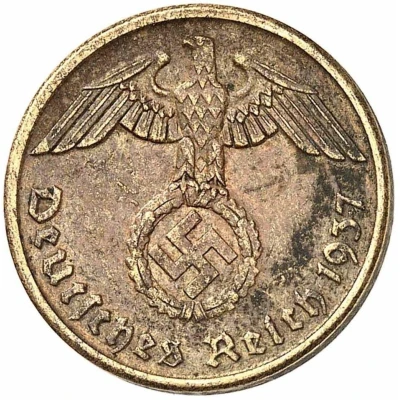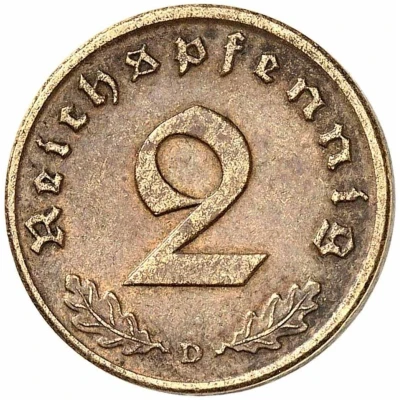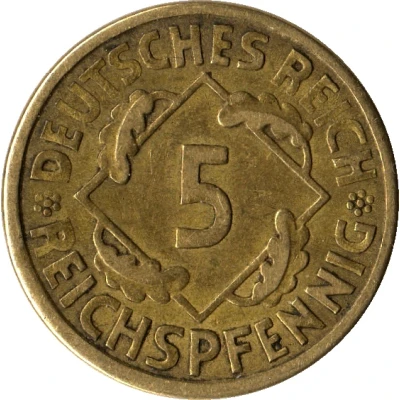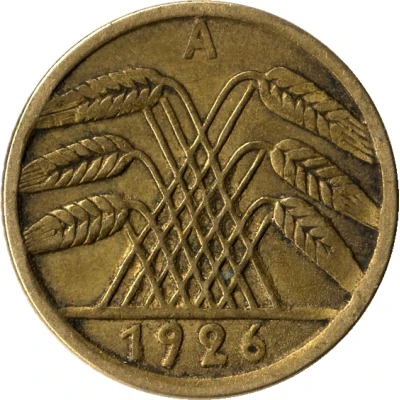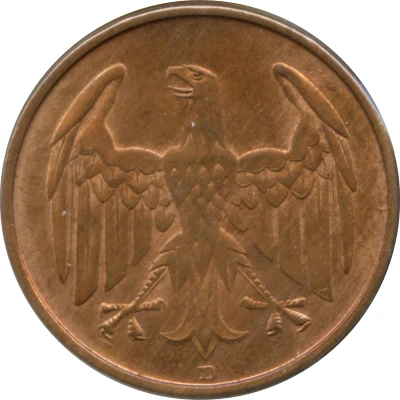
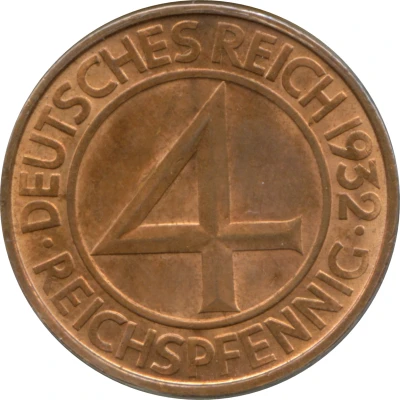

© tolnomur (CC BY-NC-SA)
4 Reichspfennig
1932 year| Bronze | 5.0 g | 24 mm |
| Issuer | Germany (1871-1948) |
|---|---|
| Period | Weimar Republic (1918-1933) |
| Type | Standard circulation coin |
| Year | 1932 |
| Value | 4 Reichspfennig (0.04 RM) |
| Currency | Reichsmark (1924-1948) |
| Composition | Bronze |
| Weight | 5.0 g |
| Diameter | 24 mm |
| Shape | Round |
| Technique | Milled |
| Orientation | Medal alignment ↑↑ |
| Demonetized | 1 October 1933 |
| Updated | 2024-10-05 |
| Numista | N#8463 |
|---|---|
| Rarity index | 11% |
Reverse
The numerical value in the center
Script: Latin
Lettering:
DEUTSCHES REICH 1932
4
REICHSPFENNIG
Translation:
German Reich 1932
4
Reichspfennig
Engraver: Reinhard Kullrich
Edge
Plain
Comment
This coin was issued in 1932 amid the Great Depression. Chancellor Heinrich Brüning's government decreed the issuance of this unusual face value on 8 December 1931, hoping that it would replace 5-pfennig coins and thereby help to reduce prices in those times of great economic hardship. The coin was, however, not very well-received by the population as it was awkward to use in a decimal system, and very few orders with the Reichsbank (central bank) were placed by banks and public institutions. Many of these coins circulated only for a short period and quickly returned to the central bank, despite instructions by the government to pay amounts of 2 marks (as a part of wages and salaries) in 4-pfennig coins. The coin was demonetized on 1 October 1933 after little more than a year in circulation. The coin's unpopularity explains its relative scarcity today.The German population used several nicknames for this coin, most of which mocked the government's naive and largely unsuccessful deflationary policy. The most popular name in general use (and still remembered by coin collectors today) was "Brüning-Taler" ("Brüning dollar", after the then German chancellor Heinrich Brüning). Varieties of this name were "Brüning-Pfennig" and "Brüning-Sechser" ("Sechser" describes a 6-pfennig coin, an allusion to the unusual face value). The Berlin newspaper "Der Tag" even held a contest to find the wittiest name for the coin. Among the proposals sent by readers were names like "Armer Heinrich" ("Poor Heinrich"; after chancellor Heinrich Brüning), "Heinrichs Taler" ("Heinrich's dollar"), "Brünette" ("brunette", a pun on the chancellor's surname), "Heini" (the chancellor's nickname), "Hilfskreuzer" ("auxiliary penny"), "Rettungsmedaille" ("rescue medal"), "Druckknopf" ("press button"), "Proleten-Dollar" ("poor people's dollar"), "Pleite-Groschen" ("bankruptcy penny"), "Nottablette" ("emergency pill"), "Krisenkitt" ("crisis putty"), "Young-Pfennig" ("Young penny", after the Young Plan to settle Germany's World War I reparations) and "Tributgroschen" ("tribute penny").
Interesting fact
One interesting fact about the 4 Reichspfennig 1932 coin from Germany is that it features a unique design that was only used for a short period of time. The coin was minted during the Nazi regime, and its design includes a stylized eagle and swastika, which were symbols of the Nazi party. This design was used for only a few years before being replaced with a new design that did not include the swastika. As a result, coins with this design are now highly sought after by collectors and can be valuable due to their historical significance.
Price
| Date | Mintage | VG | F | VF | XF | AU | UNC |
|---|---|---|---|---|---|---|---|
| 1932 A | 27100599 | - | - | - | - | - | - |
| 1932 D | 7055000 | - | - | - | - | - | - |
| 1932 E | 3729400 | - | - | - | - | - | - |
| 1932 F | 5021648 | - | - | - | - | - | - |
| 1932 G | 3050290 | - | - | - | - | - | - |
| 1932 J | 4093938 | - | - | - | - | - | - |
Values in the table are based on evaluations by sales realized on Internet platforms. They serve as an indication only for 4 Reichspfennig 1932 coin.
